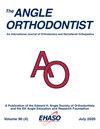Effects of Class II elastics during growth on the functional occlusal plane according to skeletal pattern and extraction vs nonextraction.
IF 3.2
2区 医学
Q1 DENTISTRY, ORAL SURGERY & MEDICINE
引用次数: 1
Abstract
OBJECTIVES To investigate the effect of Class II intermaxillary elastics on the functional occlusal plane (FOP) of growing patients. MATERIALS AND METHODS A total of 50 participants aged 11 to 16 years were selected from a university clinic archive >1-year after treatment and after undergoing 6 months of Class II elastic wear, taking pretreatment (T0) and posttreatment (T1) lateral cephalometric radiographs, and consenting to participate at recall (T2). Participants were divided into 3 groups according to skeletal pattern or into 2 groups according to treatment with extraction (E) or nonextraction (NE). Angular changes of FOP relative to the Sella-Nasion (SN), mandibular plane (MP), and Frankfort horizontal (FH) were compared within and between groups. RESULTS A statistically significant reduction of FOP-SN/FH, but not of FOP-MP, was found from T0-T1-T2 when all patients were grouped together. FOP-SN/MP/FH was significantly the largest in the patients with a hyperdivergent skeletal pattern, but lowest in the patients with a hypodivergent skeletal pattern at T0, T1, and T2 (P < .032). FOP-MP at T0-T2 was statistically larger in group E than in group NE (P < .02). No differences were found for FOP changes (change before treatment minus after treatment and change after treatment minus 1 year after treatment) between different skeletal patterns (P > .433) and treatment groups (P > .193). CONCLUSIONS Use of Class II elastics during the growth period was not found to show adverse effects on FOP rotation. Neither skeletal pattern nor treatment modality differed in the response to Class II elastics with regard to FOP changes. Individual patient growth pattern must be taken into consideration when treatment planning the use of Class II elastics. Orthodontists should take into account individual skeletal and growth patterns while using Class II elastics.依骨骼形态及拔牙与未拔牙,生长过程中II类弹性对功能咬合平面的影响。
目的:探讨II类上颌间弹性材料对成长期患者功能咬合平面(FOP)的影响。材料和方法:从一所大学的临床档案中选择了50名年龄在11 - 16岁的参与者,他们在治疗后>1年,经历了6个月的II级弹性磨损,接受了治疗前(T0)和治疗后(T1)的侧位头颅x线片,并同意在回忆时(T2)参加。根据骨型分为3组,根据拔牙(E)或不拔牙(NE)分为2组。比较各组内、组间FOP相对于Sella-Nasion (SN)、下颌平面(MP)和Frankfort水平(FH)的角度变化。结果:所有患者在T0-T1-T2分组时,FOP-SN/FH均有统计学意义的降低,但FOP-MP无统计学意义。fp - sn /MP/FH在骨型超发散患者中最大,在骨型低发散患者中最低(P < 0.032)。t0 ~ t2时,E组FOP-MP显著高于NE组(P < 0.02)。不同骨骼类型间FOP变化(治疗前减治疗后变化及治疗后减治疗1年变化)与治疗组间差异无统计学意义(P > .433)。结论:在生长期间使用II类弹性材料未发现对FOP旋转有不良影响。无论是骨骼类型还是治疗方式,在II类弹性治疗对FOP变化的反应上都没有差异。当治疗计划使用II类弹性材料时,必须考虑到个体患者的生长模式。正畸医生在使用第II类弹性材料时应考虑到个体骨骼和生长模式。
本文章由计算机程序翻译,如有差异,请以英文原文为准。
求助全文
约1分钟内获得全文
求助全文
来源期刊

Angle Orthodontist
医学-牙科与口腔外科
CiteScore
6.40
自引率
5.90%
发文量
95
审稿时长
3 months
期刊介绍:
The Angle Orthodontist is the official publication of the Edward H. Angle Society of Orthodontists and is published bimonthly in January, March, May, July, September and November by The EH Angle Education and Research Foundation Inc.
The Angle Orthodontist is the only major journal in orthodontics with a non-commercial, non-profit publisher -- The E. H. Angle Education and Research Foundation. We value our freedom to operate exclusively in the best interests of our readers and authors. Our website www.angle.org is completely free and open to all visitors.
 求助内容:
求助内容: 应助结果提醒方式:
应助结果提醒方式:


